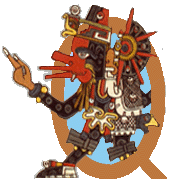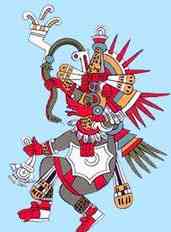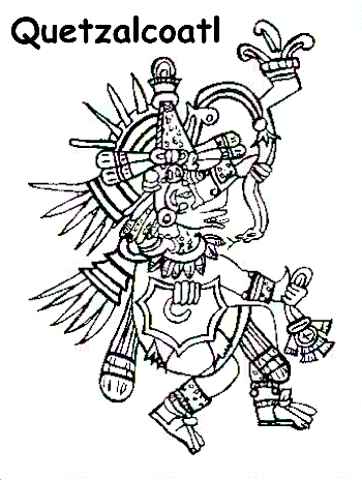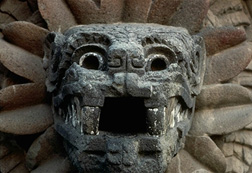Allgemein
 Quetzalcoatl
-- The Feathered Serpent Quetzalcoatl
-- The Feathered Serpent
Quetzalcoatl stands as a symbol of the creation, of the life
process. . . . Quetzalcoatl furthermore is the generator of
the arts, of sciences, and of the calendar. As protector of
the Calmecac (Aztec schools), Quetzalcoatl came to be regarded
as the supreme symbol of knowledge as well as of the whole of
Nahuatl wisdom. He represents the virtues of life: such as respeto
or creating with the heart (yolteotl).
http://numa.niti.org/naccs/quetzal.htm
The
Mystery of Quetzalcoatl
 
Nahuatl
= feathered serpent, ancient deity and legendary ruler of the
TOLTECS in Mexico (c. 800-1200AD).
http://www.rjames.com/toltec/index.asp
Quetzalcoatl
Toltec and Aztec
god and legendary ruler of Mexico,
usually referred to as the Plumed, or Feathered, Serpent, the
translation of his Nahuatl name. In the 10th century AD the
Toltecs transformed what had been a god of soil fertility,
worshiped in Teotihuacán before the 9th century, into a deity
associated with the morning and evening star, Venus. The
Aztecs later made him a symbol of death and resurrection and a
patron of priests. The opposing deity in the dualistic Toltec
religion was Tezcatlipoca
, the god of the night sky. He was
believed to have driven Quetzalcoatl from his capital, Tula
, into exile, from which, according to
prophecy, Quetzalcoatl, described as light-skinned and bearded,
would return in a certain year. Thus, when the Spanish
conqueror Hernán Cortés appeared in 1519, the Aztec king,
Montezuma II, was easily convinced that Cortés was the
returning god.
The legend of
the exile of Quetzalcoatl may reflect changes in Toltec
religion from agricultural ceremonies to the practice of human
sacrifice (also adopted by the Aztecs), or it may have been
based on the exile from Tula of a priest-king named
Quetzalcoatl in the 10th century.
http://www.fwkc.com/encyclopedia/low/articles/q/q021000119f.html
Quetzalcoatl
(from quetzalli, "precious feather," and coatl,
"snake"), the Feathered Serpent, was one of the
major gods of the Aztecs. As the morning and evening star,
Quetzalcoatl was the symbol of death and resurrection.
With
his friend, Xolotl, a dog-headed god, he was said to have
descended to the underground hell of Mictlan to gather the
bones of the ancient dead. Those bones he smeared with his own
blood, giving birth to the men who inhabit the present
universe.
Quetzalcoatl
was often shown as a man with a beard named Ehecatl, the wind
god. Sometimes he was shown wearing a mask with two protruding
tubes (through which the wind blew) and a conical hat.
http://home.freeuk.net/elloughton13/quetz.htm
 The
Feathered Serpent The
Feathered Serpent
The main deity at Chichen Itza is Kulkulkan, the feathered
serpent. This deity is more commonly known as Quetzalcoatl.
The feathers and talons of an eagle are easily discernable, as
is the human face emerging from a snake's mouth.
Quetzalcoatl
was reputed to be a blonde, bearded and blue eyed god with
white skin. Hernan' Cortez, who was blonde and had a beard,
had the tremendous good fortune to arrive on the Mexican coast
on the day that the prophecies
had predicted Quetzalcoatl's return.
http://www.execpc.com/~urbanlee/Kulkulkan.html
Quetzalcoatl
"Feathered Snake". One of the major deities of the
Aztecs, Toltecs, and other Middle American peoples. He is the
creator sky-god and wise legislator. He organized the original
cosmos and participated in the creation and destruction of
various world periods. Quetzalcoatl ruled the fifth world
cycle and created the humans of that cycle. The story goes
that he descended to Mictlan, the underworld, and gathered the
bones of the humanbeings of the previous epochs. Upon his
return, he sprinkled his own blood upon these bones and
fashioned thus the humans of the new era. He is also a god of
the wind (the wind-god Ehecatl
is one of his forms), as well as a
water-god and fertility-god.
He is
regarded as a son of the virgin goddess Coatlicue
and as the twin brother of Xolotl.
As the bringer of culture he introduced
agriculture (maize) and the calendar and is the patron of the
arts and the crafts.
In one myth the
god allowed himself to be seduced by Tezcatlipoca, but threw
himself on a funeral pyre out of remorse. After his death his
heart became the morning-star, and is as such identified with
the god Tlahuizcalpantecutli. In dualistic Toltec religion,
the opposing deity, Tezcatlipoca ("Smoking Mirror"),
a god of the night, had reputedly driven Quetzalcoatl into
exile. According to yet another tradition he left on a raft of
snakes over the sea. In any case, Quetzalcoatl, described as
light-skinned and bearded, would return in a certain year.
Thus, when the Spanish conqueror Hernán Cortés appeared in
1519, the Aztec king, Montezuma II, was easily convinced that
Cortés was in fact the returning god.
The Aztecs
later made him a symbol of death and resurrection and a patron
of priests. The higher priests were called Quetzalcoatl too.
http://www.pantheon.org/mythica/articles/q/quetzalcoatl.html
Quetzalcoatl
Thomas H. Frederiksen
 The
Creator God-The Feathered Serpent-The Founder of Agriculture- Precious
Feather Snake- The Road Sweeper The
Creator God-The Feathered Serpent-The Founder of Agriculture- Precious
Feather Snake- The Road Sweeper
Often
portrayed with a black beard to represent age or as an old
man. Covering his mouth there is often a red mask in the form
of a bird's beak. His mask identifies him as the god of wind
and he was worshiped under the name of Ehecatl, or wind. One
of the greatest gods, god of wind, light, and Venus.
He
taught men science and the calendar and devised ceremonies. He
discovered corn, and all good aspects of civilization.
The
symbol of the feathered serpent was Quetzalcoatl, meaning not
just feathered serpent, but "most precious serpent".
Quetzalcoatl is not the feathered serpent but the one who
emerges from the serpent as Venus rises from the morning
horizon.
http://www.northcoast.com/~spdtom/a-god5.html
Who
was Quetzalcoatl?
Peter Tucker
According to Mayan legend Kulkulkan, the Plumed Serpant, (called
Quetzalcoatl by the Toltecs and later the Aztecs) arrived in
Central America in a boat from across the sea. The Mayans
regarded him as the great organizer who founded cities,
formulated laws and invented the Mayan calendar. The Aztecs
revered him as a god of light. He was a bearded white man. The
Central American Indians did not have beards.
http://jester.net/Quetzalcotal.htm
THE
QUETZALCOATL "TRINITY"
Jim Tuck
It is entirely correct to think of the Aztec legend
Quetzalcoatl in three contexts -- as historical personality,
as divinity and as literary subject. In the first incarnation
he is a 10th century priest-king; in the second a deity
associated with progress and humanity; in the third an object
of intense interest to both ancient Aztec and more
contemporary European scholars.
http://www.mexconnect.com/mex_/history/jtuck/jtquetzalcoatl.html
The
Return of Quetzalcoatl the plumed serpent
Kay Sutherland
The return of Quetzalcoatl is a story of the rebirth cycle
moving from moral decadence to moral responsibility. The
Quetzalcoatl creation and destruction story is analogous to
the Hopi migration myth. In the year of Ce Acatl, Quetzalcoatl
was born of a princess impregnated by a precious turquoise. As
a young man, he was fair and pure-minded. He grew tall and
strong and brought the knowledge of corn and cotton
cultivation to his people. Being a gentle person, he abhorred
sacrifice and his friends were vulnerable creatures, such as
the bird and the butterfly. He was especially kind to the
deformed, the dwarves and the hunchbacks, who were his most
loyal followers. They kept this serious young man entertained,
much like court jesters and clowns. But the young king made
enemies. His kindness compelled him to outlaw human sacrifice,
an ancient custom among his people. The priests of Izcatlipoca,
the god of sacrifice known as "smoking mirror" for
his devious ways, felt thwarted and shunned. They plotted
against Quetzalcoatl.
They tricked
him into thinking he was not drinking fermentations with the
magic smoking mirror that hides reality. Quetzalcoatl became
very drunk on the unaccustomed beverage and was tricked again
into the most heinous of crimes, sleeping with his sister. He
had succumbed to these temptations and when he awoke and
realized his sins, he became deeply depressed. His deformed
friends tried to cheer him up, but he said he would have to
give up the kingship and travel . The loyal friends begged him
not to leave but the depressed king felt he was no longer
worthy. So he went into voluntary exile on a long journey as
penance for his actions. The dwarves and hunchbacks
accompanied him, though people laughed at them., for they
would not abandon they gentle leader. They traveled east to
the coast and found an ocean. Here he stopped and asked them
to make a huge pyre of wood. He staked himself to the pyre and
told them he would return someday and that they should not
feel that he was abandoning them. He lit the fire. The humped
back dwarves said that the fired raged and rose high to sky
and from out of the pyre came a bright, shining star.
 The
Hopis believe that when the Bright Shining Star returns, this world
will end and the Fifth World will begin, a time when all people
will come together and live peacefully. Civilization
as we know it will die so that a cleaner, purer life can begin.
In the cycle of civilizations, moral decadence precedes moral responsibility. The
Hopis believe that when the Bright Shining Star returns, this world
will end and the Fifth World will begin, a time when all people
will come together and live peacefully. Civilization
as we know it will die so that a cleaner, purer life can begin.
In the cycle of civilizations, moral decadence precedes moral responsibility.
http://www.rainhouse.org/Quetzal.htm
Tlahuizcalpantecuhtli
Tlahuizcalpantecuhtli was an Aztec god whose symbols were the
planet Venus
and the feathered serpent, Quetzalcoatl. The Aztecs believed
that Tlahuizcalpantecuhtli ruled the sky at noon (the twelfth
hour of the day). Rituals were performed when the planet Venus
was aligned with the Pleiades, known by the Aztecs as Tianquiztli.
http://windows.ivv.nasa.gov/cgi-bin/tour_def/mythology/tlahuizcal_venus.html
The
Feathered Serpent Pyramid Pages

These pages about the Feathered Serpent Pyramid, Teotihuacan,
Mexico, have been designed for students, scholars and the
general public. The information used here is provided by an
international archaeological research project focused on the
Feathered Serpent Pyramid at Teotihuacan.
http://archaeology.la.asu.edu/teo/fsp/index.htm
|




